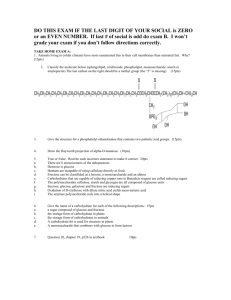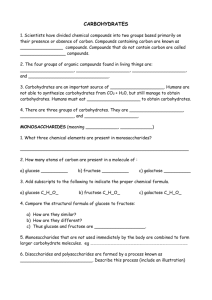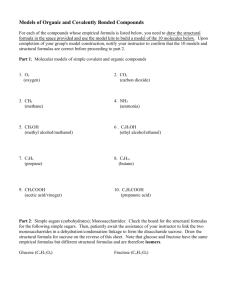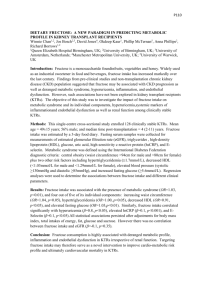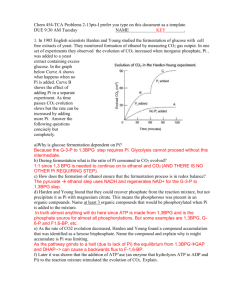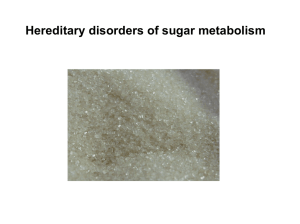Metabolism of Fructose and Galactose
advertisement
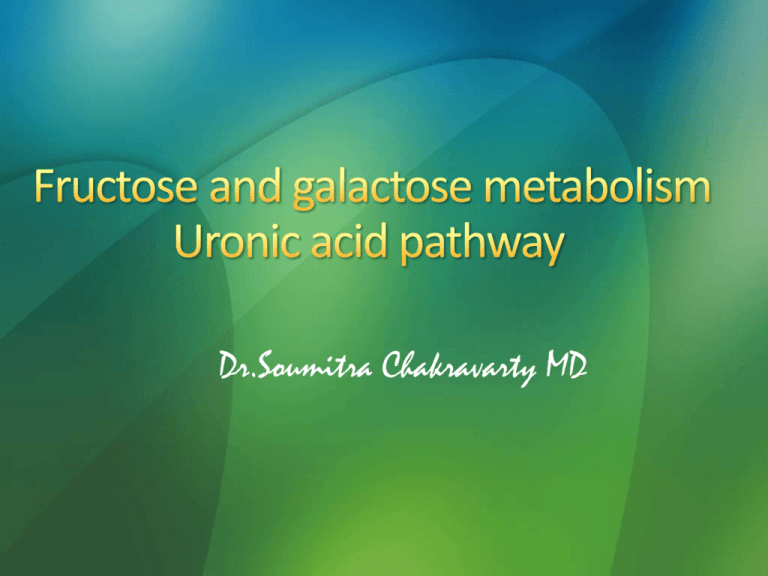
Dr.Soumitra Chakravarty MD List the key enzymes of Galactose and Fructose metabolism Differentiate the clinical features and the enzyme deficiency in essential Fructosuria and hereditary fructose intolerance Differentiate the clinical features and enzyme deficiency in non classical and classical Galactosemia Briefly describe lactose intolerance and its clinical manifestations Describe the pathogenesis of Diabetes Mellitus and its complications. SYNTHESIZES URONIC ACID URONIC ACID IS REQUIRED FOR :A. Synthesis of GAGs Synthesis of Glycoproteins and Proteoglycans B. Conjugation of Bilirubin and Drugs Fructose enters glycolysis either as fructose 6-po4 or fructose 1-po4. Phosphorylation by Hexokinase or fructokinase Fructokinase found in liver, kidney and small intestine Hexokinase in skeletal muscle and most organs Features of Fructose metabolism Entry of fructose into the cells is – not dependent on insulin. Phosphorylation to fructose -1- phosphate by enzyme fructokinase in liver. 1. Is not dependent on amount of fructose in plasma 2. Is not dependent on insulin. In extra hepatic tissues: glucose competes with fructose for hexokinase. Fructose metabolism Muscle which contains only hexokinase phosphorylates fructose to F6P which is a direct glycolytic intermediate. Hepatic fructose is phosphorylated on C-1 by fructokinase yielding fructose-1phosphate. Enzyme Hexokinase Glucokinase Fructokinase Substrate All Hexoses Glucose Fructose Location All tissues Liver Liver Affinity High affinity (Glucose> Fructose) Low affinity High affinity for FRUCTOSE Velocity of reaction Slow Fast Fast Phosphorylation POSITION 6-PO4 6-PO4 1-PO4 Bypass rate limiting step (PFK-1) No No Yes Regulation by insulin Not regulated Regulated Not regulated Uric acid SLOWER FASTER Aldolase A , B and C. Aldolase B is present in liver, kidney and small intestine converts fructose 1-P into DHAP and glyceraldehyde. Aldolase A is a glycolytic enzyme in all other tissues. Aldolase C is present in Brainsimilar to aldolase A Kinetics of metabolism Rate of fructose metabolism > rate of glycolysis since fructokinase/Aldolase B bypasses PFK-1 – the rate limiting step of glycolysis. Elevated levels of dietary fructose increased rate of lipogenesis( fatty acid and triglyceride synthesis) in liver as a result of Acetyl CoA and glycerol-3PO4 accumulation formed by the more rapid fructose metabolism . Remember – Sucrose contains glucose + fructose !! PROVIDES ENERGY SEMINAL PLASMA – ENERGY REQUIRED FOR MOBILITY OF SPERMATOZOA Secreted by Seminal Vesicle Fructose ATP Fructokinase Essential Fructosuria def ADP Fructose-1-Po4 Aldolase B Glyceraldehyde def Hereditary Fructose intolerance Dihydroxyacetone phosphate Fructokinase deficiency: Autosomal recessive – benign condition Excretion of fructose in urine [ no other abnormality] Wrong diagnosis of Diabetes mellitus Treatment Avoid fructose . Hereditary Fructose intolerance Deficiency of aldolase B Accumulation of fructose-1- phosphate Deficiency of phosphates in cells. Liver failure Hypoglycemia Hyperuricemia Liver failure – glycogen accumulation. Hyperuricemia Hypoglycemia Inhibition of glycogen phosphorylase. + Depletion of ATP also hampers Gluconeogenesis Hypoglycemia Depletion of ATP.AMP rises and in absence of inorganic Pi , AMP is destroyed (because the end product of purine catabolism is Uric acid ) Acute ingestion – vomiting, nausea etc. Prolonged fructose ingestion in infants leads to poor feeding, vomiting, hepatomegaly, jaundice, hemorrhage, proximal‐renal‐tubule syndrome (fanconi like syndrome) Note :- Don’t confuse facconi’s syndrome with Fanconi’s anaemia !! Aldose reductase – lens, retina, kidney cells, Schwann cells, placenta, cells of ovaries and seminal vesicles. Aldose reductase Sorbitol dehydrogenase No sorbitol dehydrogenase Compliations due to increased glucose: Hyperglycemia (as in diabetes) results in elevated levels of intracellular glucose in lens, nerve, kidney. This leads to water retention in these tissues due to osmotic effects of sorbitol swelling, cataract, peripheral neuropathy and vascular problems nephropathy and retinopathy as complications of diabetes Harpe29th ed Functions of Galactose in Body Energy Converted to Glucose Synthesis of Lactose Synthesis of Glycosaminoglycans Glycoproteins and Proteoglycans Harper 29th Galactose Glycogen Glucose 1P Galactose 1p Glucose 1P Glucose 6P Glucose Galactose GALACTOKINASE UDP Glc Galactose 1 P GALACTOSE 1 P URIDYL TRANSFERASE UDP Gal Glucose 1 P Glucose 6 P Glucose 1. Galactokinase deficiency 2. Galactose 1-phosphate uridyl transferase deficiency 3. UDP-galactose 4 epimerase deficiency. UDP -Galactose UDP-galactose is required for biosynthesis of: Lactose Glycoproteins Glycosaminoglycans Glycolipids Non Classical Galactosemia Deficiency of enzyme Galactokinase Autosomal recessive Less severe compared to classic type. Early onset of cataract in first few months of life. Classical Galactosemia Galactose 1-phosphate uridyltransferase deficiency (GALT) deficiency Galactosemia, Galactosuria, vomiting, Diarrhoea, jaundice, cataract formation Liver damage- cirrhosis and brain damage - mental retardation Accumulation would inhibit the production of the second messenger inositol in the signalling system and hence causing a mental retardation. Lippincott’s Galactitol Liver Damage and Cirrhosis due to accumulation of Gal-1P Gal-1P gets deposited in Renal tubules A newborn vomits after each feeding of milk based formula and does not gain weight. Biochemical testing reveals a severe def of Galactose-1phosphate uridyl transferase. If this condition goes untreated, which of the following is the likely outcome for this patient? A. B. C. D. E. Benign disease except for cataract formation Chronic emphysema appearing in early adulthood Chronic renal failure appearing in adolescence Mental retardation and later death in infancy Gastrointestinal symptoms that remit with puberty A 4-month-old infant is brought to emergency clinic by the parents in an unconscious state. The mother complains that the child has had repeated attacks of unconsciousness, especially in the night, in the past few months. On examination, the child had massive Hepatomegaly. Biochemical tests revealed that the blood glucose level was 40mg/dL. The lactate and triglyceride and uric acid levels in circulation were increased. Urine did not contain any reducing sugar. The developmental milestones of the child were normal; however, the weight gain of the infant was poor. Administration of glucagon failed to increase the blood glucose level. What is the most probable biochemical defect? Von Gierke disease Classical Galactosemia Hereditary fructose intolerance Essential Fructosuria Medium chain acyl Co-A dehydrogenase deficiency
